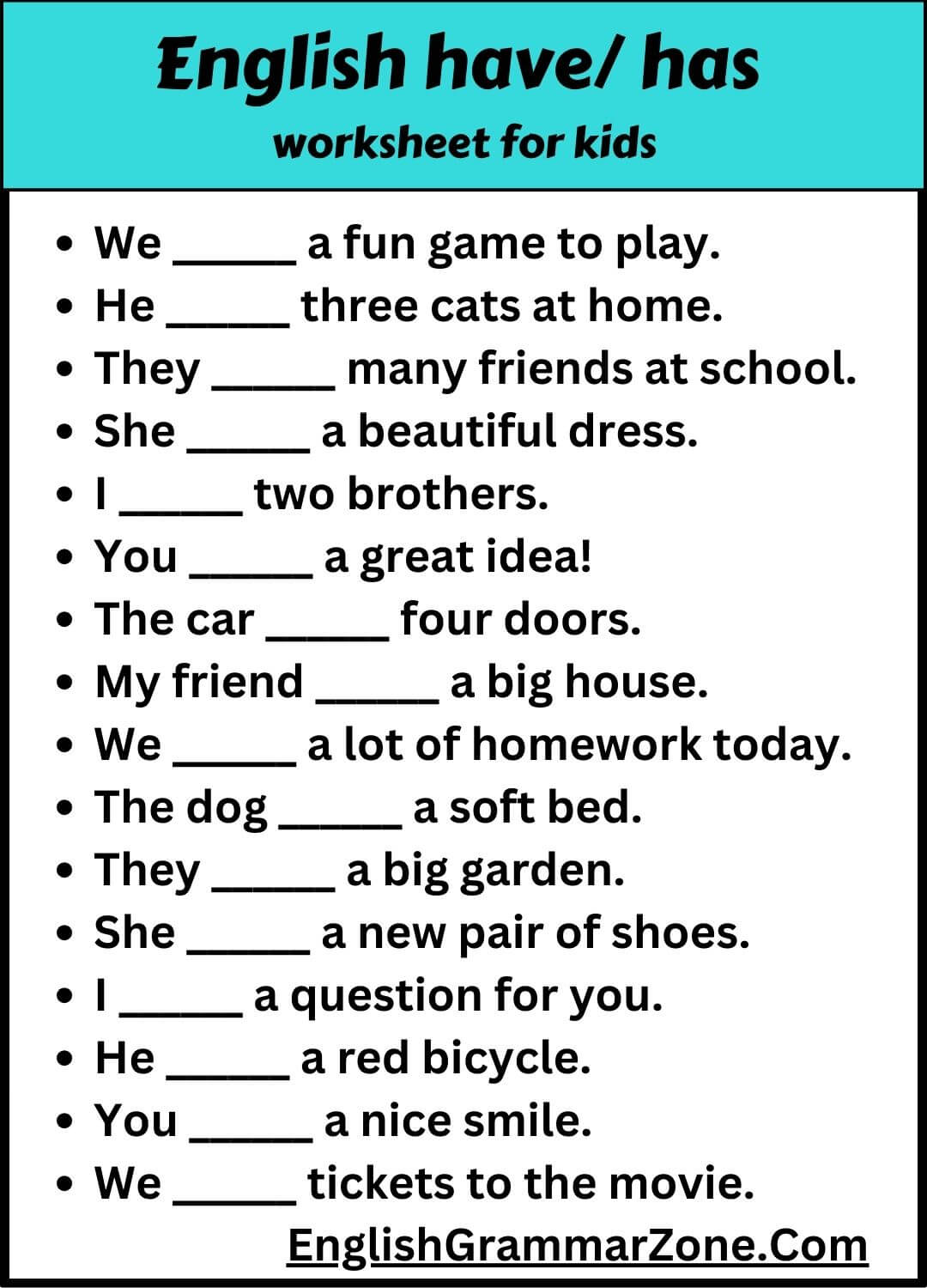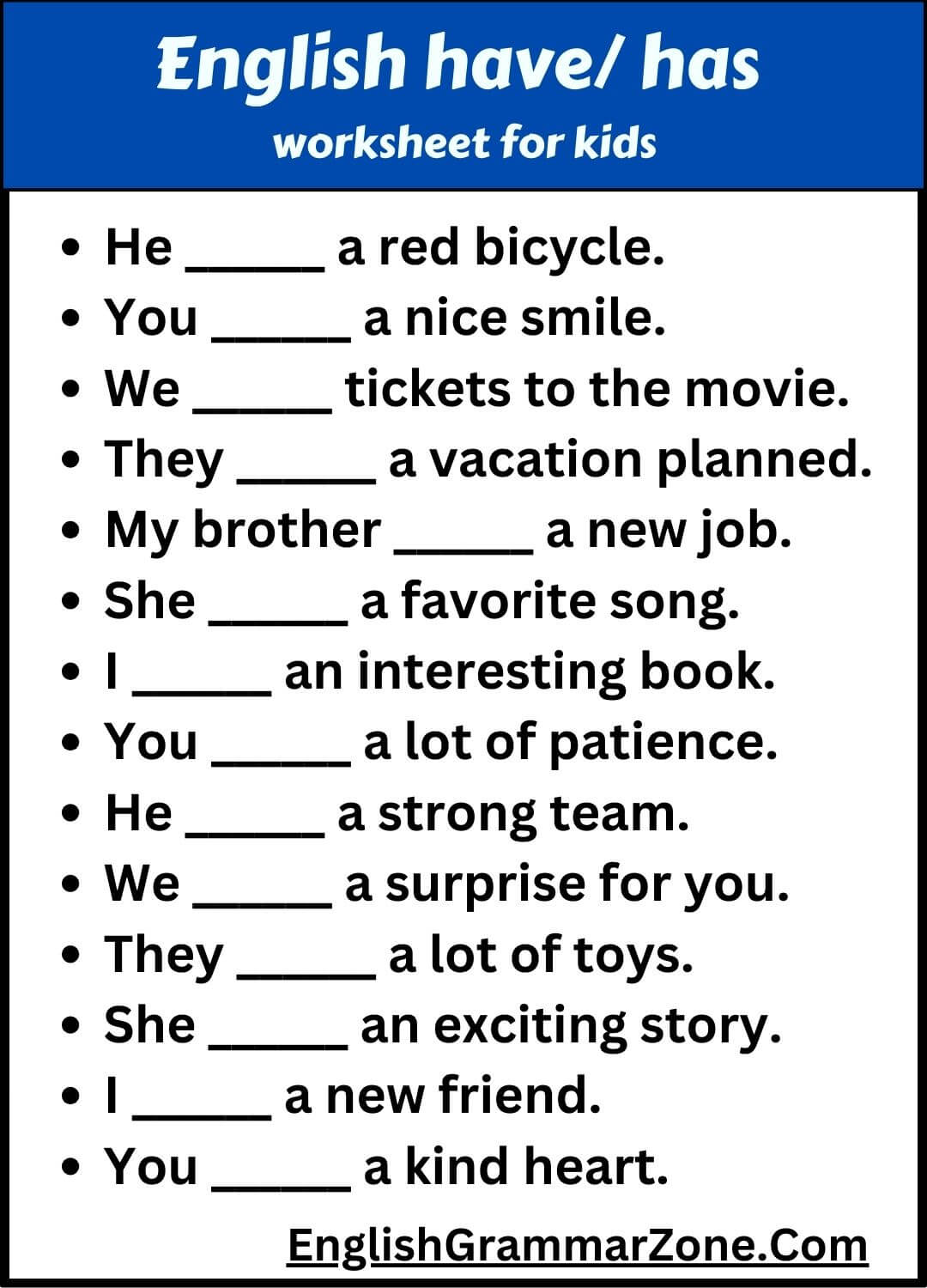Learning the correct usage of “has” and “have” is an essential part of mastering English grammar. Whether you’re a beginner or looking to brush up on your skills, a Has and Have Worksheet can be an effective tool to help you understand and practice these two verbs. “Has” and “have” are commonly used in English to indicate possession or actions, and knowing when to use each one correctly can make a significant difference in your communication skills.
The worksheet is designed to help learners grasp the differences between “has” and “have,” offering exercises that focus on various contexts. By completing a Has and Have Worksheet, students can practice forming sentences, identifying the right context for each verb, and improving their overall grammar proficiency.
Both “has” and “have” belong to the verb group called auxiliary verbs. The difference between them largely depends on the subject of the sentence. “Has” is used with third-person singular subjects (he, she, it), while “have” is used with first-person, second-person, and plural subjects (I, you, we, they). This basic rule, although simple, can be tricky for English learners, especially when it comes to exceptions or irregular uses.
Using a Has and Have Worksheet allows you to see these rules in action. It offers a variety of exercises, from fill-in-the-blank sentences to transforming statements, helping you to not only understand but also practice how “has” and “have” fit into different sentence structures. Whether you’re doing it for homework, self-study, or classroom activities, a worksheet is a great way to reinforce what you’ve learned.
The Has and Have Worksheet is designed to be simple yet thorough. It helps learners identify patterns, understand subject-verb agreement, and distinguish between singular and plural forms of the verb. Additionally, by practicing with this worksheet, you gain confidence in your ability to use “has” and “have” correctly in conversations and written communication.
In this article, we’ll provide answers to common questions about Has and Have Worksheet and how they can be useful in your learning journey.
Has / Have Worksheet For Kids
Fill in the blanks with either “have” or “has” to complete each sentence correctly
- We ______ a fun game to play.
- He ______ three cats at home.
- They ______ many friends at school.
- She ______ a beautiful dress.
- I ______ two brothers.
- You ______ a great idea!
- The car ______ four doors.
- My friend ______ a big house.
- We ______ a lot of homework today.
- The dog ______ a soft bed.
- They ______ a big garden.
- She ______ a new pair of shoes.
- I ______ a question for you.
- He ______ a red bicycle.
- You ______ a nice smile.
- We ______ tickets to the movie.
- The book ______ colorful pictures.
- They ______ a vacation planned.
- My brother ______ a new job.
- She ______ a favorite song.
- I ______ an interesting book.
- You ______ a lot of patience.
- He ______ a strong team.
- We ______ a surprise for you.
- The bird ______ bright feathers.
- They ______ a lot of toys.
- She ______ an exciting story.
- I ______ a new friend.
- You ______ a kind heart.
- He ______ a good sense of humor.


Frequently Asked Questions (FAQ)
1. What is the difference between “has” and “have”?
The primary difference between “has” and “have” lies in the subject of the sentence. “Has” is used with third-person singular subjects (he, she, it), while “have” is used with first-person, second-person, and plural subjects (I, you, we, they).
- Example with “has”: She has a new book.
- Example with “have”: I have a new book.
2. Why is it important to learn “has” and “have”?
Understanding the correct usage of “has” and “have” is essential for proper sentence structure in English. These verbs are used to express possession, actions, or states of being, and using them correctly makes communication clearer and more effective. Without understanding the difference, it can lead to confusion or grammatical mistakes.
3. Can I practice “has” and “have” on my own?
Yes! A Has and Have Worksheet is a great way to practice on your own. It provides exercises that help you understand when to use “has” and when to use “have.” By completing worksheets, you reinforce the rules and gain confidence in using these verbs correctly in sentences.
4. How can a worksheet help me learn “has” and “have”?
A worksheet is a practical learning tool that allows you to engage with the material actively. It helps you apply the rules in different contexts and solidify your understanding. Through exercises such as fill-in-the-blank and sentence transformation, you get direct practice with both verbs, which is crucial for improving your grammar skills.
5. Are there any common mistakes with “has” and “have”?
Yes, a common mistake is confusing “has” with “have” when using singular and plural subjects. For instance, people often say “I has a book” instead of “I have a book” or “She have a cat” instead of “She has a cat.” These errors can be corrected through consistent practice and attention to subject-verb agreement.
6. How can I get better at using “has” and “have”?
The best way to improve is through regular practice. Use worksheets, read more in English, and try to write sentences or short paragraphs using “has” and “have.” Additionally, listening to native speakers or engaging in conversations will help you hear how these verbs are used in natural contexts, which can further enhance your understanding.
By practicing regularly with a Has and Have Worksheet, you’ll build a strong foundation in grammar that will help you communicate more clearly and accurately in English.

